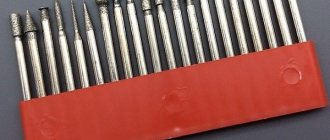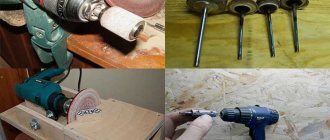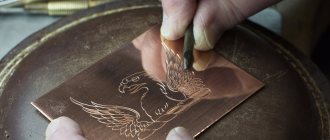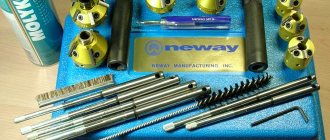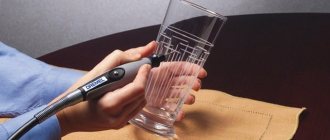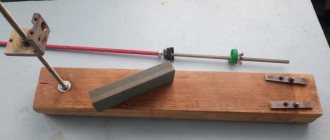Homemade attachments / cutters / consumables for engravers, drills and drills
The article will touch upon the topic of how to make consumables with your own hands. It's no secret that Chinese nozzles are of very low quality, while branded ones are overpriced. So in some cases it will be more profitable to do it yourself. Under the cut you will see my homemade attachments and also interesting solutions from the Internet .
- Abrasive attachments
- Petal circle for engraver
- Original sandpaper on a rubber drum does not last long, so you need to find an alternative solution. Cut out a circle of small diameter from plywood:
Let's give it a more even shape:
Making cuts with a hacksaw for metal:
We glue sandpaper into the resulting slots using epoxy resin:
We get:
Flap wheel for drill
The nozzle has a larger diameter. To prevent a “spread” as in the previous version, when gluing, the sandpaper must be tightened with an elastic band. This occurs because the base of the fabric absorbs the resin from the cut and becomes rough.
Finished nozzle:
- The advantage of flap wheels is that they last an order of magnitude longer than regular sandpaper on a drum of the same diameter.
- Emery for a drill from rollers from a tape recorder
- Older reel-to-reel tape recorders have large rubber rollers with a metal sleeve. We place a bolt on the bushing and glue sandpaper onto the rubber:
- Cutting wheels for engraver
- The topic is quite common, but I’ll still tell you for the sake of completeness.
- We take a thin cutting disc for an angle grinder, a compass with two needles, an awl, and unnecessary scissors:
1) We draw circles with a compass (you shouldn’t make too large circles, it’s inconvenient to work with them. The optimal size is slightly smaller than a standard circle) Make sure that the center of the circle is in the middle of one of the squares of the reinforcing mesh.
2) Use scissors to cut the disk into sectors, and then cut out the circles themselves located in the sectors. Metal scissors are suitable for this work, but ordinary stationery scissors can also be used, but this makes them more dull, so we take those scissors that we don’t mind.
3) Using light rotational movements of the awl, we begin to make a hole alternately on both sides. The diameter of the hole must be equal to the diameter of the screw. If the hole is any larger, it will break.
- 4) Grind the circle at low speed on an unnecessary sharpening stone:
- And we get reinforced cutting wheels:
Making such circles is much cheaper than buying them. They also last longer than purchased non-reinforced circles.
Decorative sanding attachment
A self-tapping screw without a head is screwed into the cork, and a washer is glued to the base. The chuck's jaws will rest against the washer and prevent the screw from being screwed in deeper.
- It is most convenient to use this attachment on a drilling machine. Instead of a self-tapping screw, you can screw a felt attachment into the cork:
- Drill polishing attachment
Another fairly common topic. The felt from the felt boot is clamped with a bolt with wide washers. Polishing paste, such as GOI paste, is applied to the felt.
- The following are a few examples of abrasive attachments taken from the Internet.
- Sanding drum for drill
- Sanding drum for engraver
On a lathe, a metal drum is turned with a slot into which the edge of the najak is tucked, and it is wrapped around the drum. Fixation occurs with an elastic band. The same structure can be made from plywood, as shown in the previous version.
- Grinding cylinders for engraver
- Comrade Marshall suggests making cylinders this way, I quote:
- In order to make this type of consumable, we will need: a durable, but as thin as possible fabric (preferably cotton), sandpaper of the required grain size, and most importantly, a tube of suitable diameter, on which the cylinders will be placed during gluing.
So, we take the fabric and cut it into long strips 12 mm wide. Then we cut these strips to the size of the diameter of the tube with an overlap of about 1-1.5 cm, pull them tightly onto the tube (so that they do not dangle) and glue our pieces directly on the tube using regular PVA.
The next task is a little more complicated: you need to correctly make a stencil, according to which the skins themselves will be cut out in the future. The stencil is shown in the picture on the right under the tube. We do this: take and cut off a piece of skin the same width as the fabric, but 1 cm longer. We apply it on top of the glued fabric and mark the place where the two ends of the skins should meet.
After this, we carry out the necessary geometric actions: from the point of the proper junction we draw a line across the skin, from the other end of the skin, at the same distance, we do the same, after which we draw diagonals in the resulting rectangles and cut off pieces of skin along these diagonals.
Now, when you place your stencil on top of the fabric glued to the tube, you get an accurate diagonal connection of the ends of the sandpaper. Now you have a stencil that you can trace with a pen along the outline on the back of the sandpaper.
Engraver attachments - types, purpose, application features
In terms of its functionality, an engraver is very similar to a conventional drill or grinder, but its main purpose is to process parts of miniature size.
Using such equipment and special working attachments for the engraver, you can effectively perform various technological operations, which include drilling, milling, grinding, engraving, etc.
Cutting a steel pipe with a cutting disc for a drill
The list of materials that can be processed using an engraver is also quite extensive.
These are soft and malleable wood, hard steel, fragile glass or ceramics, various types of plastic and even bone.
Naturally, to process different materials with an engraver, different working attachments are used, differing in both design and material of manufacture.
What are engraver attachments?
Working attachments or tools used to work with an engraver are presented in a wide variety on the modern market. Their design includes two main elements:
- a shank with which the tool is fixed in the chuck of the equipment used;
- the working part, which performs the main functions, interacting with the material being processed.
The working part of these nozzles is designed for processing metal surfaces
The choice of working attachments for an engraver is influenced by the following factors: characteristics of the material being processed and the list of technological tasks that need to be performed.
Those home craftsmen and specialists who work with an engraving machine on a regular basis try to immediately purchase a set of attachments for the engraver, which includes tools of various sizes and purposes.
Depending on the needs and financial capabilities of a particular engraving artist, this may be a more modest set, including several dozen necessary tools, or a professional set, which includes attachments for performing various works on metal, wood and other materials.
When choosing working tools for an engraver, you should take into account that some of its models can be equipped with collet chucks that are suitable for attachments only of a certain brand. To use such equipment in conjunction with any type of attachments, you will have to purchase universal collets for the engraver, which are also sold in whole sets.
Diamond burs for engraving work
The most popular types of working attachments used to complete engraving installations include diamond burs for engravers.
The base of such a tool is made of tool steel, and diamond powder is applied only to their working part.
The mechanical characteristics of diamond powder make it possible to successfully use the attachment for processing hard materials such as steel, ceramics, glass, artificial and natural stones.
Expensive dental diamond burs have a long service life
Diamond burs (or cutters) are used primarily for finishing shaped holes.
As a rule, diamond consumables for engravers are sold in whole sets of 10–20 tools of various shapes and sizes.
When working with them, you should strictly follow the rules of their operation so as not to damage the diamond coating. The standard shank diameter of diamond-type engraving bits is 3 mm.
Abrasive tools
The most budget-friendly option for use in conjunction with a drill or engraver are attachments, the working part of which is made of rubber and abrasive material.
The diameter of their shank is 2.3 mm, and they are used mainly for work on metal, including stainless steel.
Abrasive tools are usually sold in sets of 6 pieces and have different working part configurations.
Abrasive cutters (aluminum oxide) for processing steel and non-ferrous metals
Some manufacturers (in particular,) produce abrasive engraving attachments in various colors, which allows the user to easily determine the category of the tool.
Thus, red abrasive wheels, intended for working on metal, are made of aluminum oxide, and green ones, made of silicon carbide, are used for processing stone, glass and ceramic products.
For the convenience of performing various technological operations, diamond cutters are made with different shapes of the working part, but their shanks always have the same diameter.
Using abrasive attachments for an engraver, operations such as boring holes, grinding surfaces, etc. are performed. These attachments are optimal for use at home; for a professional, their capabilities will not be enough.
Nozzles can be in the form of removable working heads mounted on the corresponding shank
Working attachments for grinding and polishing
An engraving machine, as mentioned above, can be successfully used for fine grinding and polishing of products made from various materials.
A roller cutter made of felt is used as a working attachment to perform such technological operations.
Since felt does not have outstanding abrasive qualities, such a tool is used only in conjunction with special polishing pastes.
Polishing discs can be used for roughing or finishing, as well as for finishing irregularly shaped surfaces
The choice of polishing pastes of a certain type, which differ significantly from each other in their characteristics and chemical composition, depends primarily on the properties of the material that will be processed with their help. Thus, grinding of hard metal surfaces is performed using pastes based on paraffin and polishing powder.
Special polishing pastes based on diamond powder of various fractions are intended for work on wood and glass. With their help, you can not only effectively remove scratches from the surface of wood and glass, but also bring the product into a perfectly smooth state.
Packaging and equipment
The Dremel comes in its original packaging, which has a picture of the tool itself and some advertising information.
The main characteristics are drawn on the side of the box
The other side of the box has the same print.
On the second side there is a description of accessories.
At the top, only the name is large src=”https://pic.mysku-st.ru/uploads/pictures/04/62/56/2017/11/06/b14c2a.jpg” class=”aligncenter” width=”800″ height =»534″[/img] The box contains a set of 30 different abrasive attachments.
The set is closed with a plastic transparent lid, each nozzle sits in its own place
Here's a closer look at the nozzles. Everyone will find something suitable for themselves. The length of each nozzle is about 45 mm
The set includes a convenient attachment for vertical milling, with adjustable immersion distance into the material.
They gave us safety glasses as a gift. And then in a bag, in bulk, they gave us a lot of gadgets for the home handyman. That's all this scattering
Cutting discs
Different size collets, Spare brushes
Polishing felt wheels and original attachment + special attachment for attaching the pads
A large set of sanding wheels in two sizes and special attachments for them
The set includes 2 keys for tightening the attachments in the chuck. Attachment for installing cutting wheels.
Brush attachments
Various options of cutters 2 drills
The most pleasant accessory for me is the flexible shaft. It allows you to work without straining, holding it just like a pen.
Appearance Dremel Made in bright red color.
The sticker shows the model. There is a special black skirt to comfortably hold the Dremel tip
Here is the Specifications Sticker. The Dremel has a power of 180W and reaches up to 30,000 rpm.
- Here is the speed regulator. There is a special bracket for hanging the Dremel when working with a flexible shaft
Metal “button” for tightening the bits in the chuck.
European plug
To replace the brushes, you don’t have to disassemble the Dremel; there are 2 special compartments for hot replacement; you just need to unscrew the 2 caps on the sides
Engraver attachments
There are simply a huge number of different tools on sale that can be used for machining parts. An example would be an engraver.
In many ways, this tool is similar in principle to a drill or grinder, but is designed for working with small-sized workpieces. By purchasing and installing various attachments for the engraver, you can carry out grinding, milling or engraving, as well as drilling.
It is important to choose the most suitable versions of nozzles, since they are characterized by different performance qualities and areas of application.
Engraver attachments
Features of nozzles
Attachments for wood drills can be classified according to a fairly large number of different characteristics. There is a wide variety on the market. Almost all equipment for an engraver is characterized by the presence of two structural elements:
- The shank is a part of the engraver attachment, due to which it is mounted in the chuck of the equipment used.
- The working part is responsible for directly removing the metal layer at the time of processing.
Examples of attachments
Metal engraving paste is used to significantly increase the efficiency of the processing, especially if the engraving tool is intended for surface grinding. Descriptions of attachments may be provided by manufacturers, since the cutting edge of some versions may have complex geometry.
Types of attachments for engravers
Equipment for an engraver can have simply a huge number of distinctive features. Drill burs and other types of equipment can be classified according to the following criteria:
- Type of material being processed.
- Purpose of the drill and the engraver attachment used.
- Areas of use.
Recommendations for selection
A set of attachments for the engraver is produced under various brands. As previously noted, when frequently processing workpieces with the tool in question, a fairly large set of attachments is required. The following factors may influence your choice:
- What specific technological tasks will have to be performed. As previously noted, a drill can be used to carry out simply a huge number of technological tasks: engraving, surface grinding, cutting, drilling and others. The choice is made in accordance with what kind of work will be carried out. There are universal sets available for sale, represented by a combination of nozzles of various types.
- Characteristics, geometric features of the workpiece and the type of material used in manufacturing.
- Estimated dimensions of workpieces. A tool that is too small is not convenient for processing larger workpieces. However, achieving your goals may take much longer.
The set of cutters and other attachments can be minimal or include several dozen units. In this case, the choice depends on the budget allocated for the purchase of equipment and how often the work will be carried out.
When choosing, attention is also paid to the classification according to the purpose of the sets:
- Professional level. The high cost of such a proposal is primarily due to its long service life and exceptional performance. In addition, the cutting part retains its shape over a long period, which ensures precision processing. It is advisable to choose such equipment only when the relevant work is carried out frequently.
- Budget proposals. This group can be divided into simply a huge number of categories. The most affordable tool will be an offer from Chinese manufacturers, but it will not last long and often does not meet the stated characteristics. Some well-known manufacturers also produce instruments of this class, but at the same time they maintain a fairly high level of quality. That is why, when work is carried out infrequently, attention should be paid to such a proposal.
Types of attachments for engravers
When purchasing a tool, you can inspect it. There should be no obvious mechanical defects on the surface. In addition, a lot of attention is paid to symmetry, which is quite difficult to check without special equipment.
